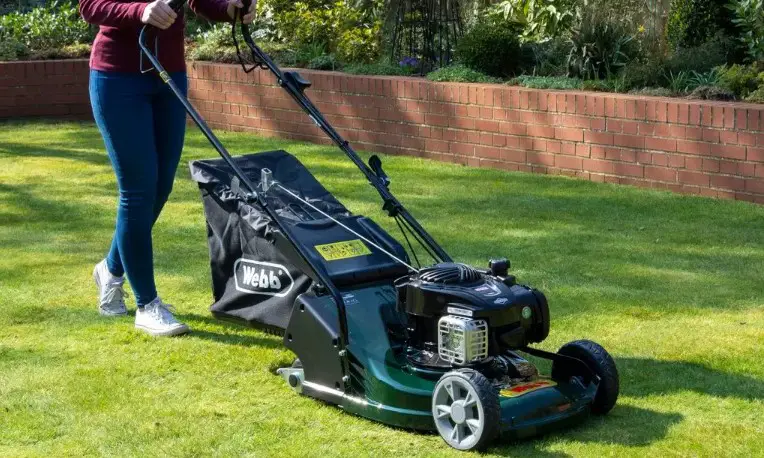When it comes to choosing a new lawnmower there are hundreds of options. So many, in fact, that it can be overwhelming.
However, there are basically only two types: a cylinder mower (or reel mower) and a rotary mower.
So, what’s the difference between the two, and which one should you buy?
To answer this, you need to know exactly what they are and how they work. Happily, that’s just what we’re going to investigate here! We’ll focus more heavily on rotary lawn mowers as these are a more recent invention and you’ll find reports out there suggesting that they’re not always the best choice.
We’ll address these concerns along the way, and discover their strengths and weaknesses.
*You’ll find that we use both lawn mower and lawnmower here. After all, neither is technically wrong! In the UK we tend to use the latter, as one word, while American English breaks it into two words. In the interests of being inclusive, we’re using both terms.
A (Very) Short History Lesson
Don’t panic, this won’t take long! As fascinating as the history of lawn mowers is, this isn’t the time or place to delve into it too deeply. Even so, it’s worth knowing that the first models were developed from the knapping machines by Edwin Budding in 1830. He took inspiration from the devices that stripped excess cloth from wool. You’ll find various other claims on the internet about who invented the lawn mower. Without exception, these are ludicrous and should be ignored.
These new grass cutting machines used a cylinder with several blades that spun around at high speed, shaving and shaping the woven wool. Budding fitted these to a metal frame with wheels that could be pushed along level ground to cut grass instead of wool, and the cylinder mower was born.
A Close Shave
The spinning blades were set against a fixed metal plate, with only a small gap between the two. This created a scissor action, as the blades had a slight curve to them that swept along the cutting edge to trap and incise the grass neatly and perfectly.
Cylinder lawnmowers also incorporated a rear roller made of metal, which flattened the grass along with any slightly uneven surfaces. Rear rollers also helped produce the distinctive stripes in the lawn that so many of us covet.
Cylinder Lawn Mowers
Essentially, the principle remains the same, although the mowers have evolved dramatically over the last two centuries.
For example, we now have electric mowers, petrol lawnmowers, battery-powered cordless lawnmowers, and robotic lawnmowers! Soon after their introduction, many models were fitted with a grass box to catch the grass clippings, saving the hard work of raking it all up afterwards.
All of these developments were designed to make garden maintenance easier, and, for the most part, they do the job very well.
But what about rotary lawn mowers? How do they differ from cylinder mowers? Are they better or worse?
Rotary Mowers
The main difference between these and cylinder mowers is that they have horizontal blades fixed to a horizontally spinning disc or directly to the drive shaft. To be more accurate, it is a single blade that forms two cutting edges. This device rotates at high speed, chopping through grass without the need for a cutting plate, as with a cylinder lawn mower.
Again, contrary to some of the more ludicrous claims you’ll find on Google, the first commercially successful rotary lawnmower was invented in 1952 in Australia. Before this, nobody could come up with a small engine that could spin the blades at a sufficient speed to be effective.
What’s The Problem?
This brings us to the ‘problem’ with rotary lawn mowers: it is the pure speed of the blade that cuts the grass. Yes, the cutting blade is sharp (at least to begin with) but it effectively tears or smashes the grass blades. This leaves the grass with broken and jagged ends that can turn brown or leave an uneven finish.
This is even more so if a plastic blade is used or a metal one isn’t kept sharp. Plastic blades are prone to breaking if they hit an obstacle, like a stone. Metal blades can generally cope with these, but they will need regular sharpening to be effective.
Essentially, cylinder mowers are believed to provide a neater, crisp finish to shorter lawns on a very level surface, while rotary lawn mowers are better suited to longer lawns, especially if the ground isn’t level.
It’s Not All Bad News!
Conventional wisdom among horticulturists and aficionados of all things garden-related says that when you mow your lawn you should aim to only remove one-third of the stem. This leaves enough to allow the lawn to stay healthy and grow new shoots.
This means that if you keep your lawn very short, you’ll need to trim it more often, which is where a cylinder lawn mower excels. However, you’ll have to do the job more frequently as these machines can’t cope with long grass.
While rotary mowers are better for longer grass, with a medium to high cutting height, your grass won’t need cutting as often, and if your lawn isn’t perfectly level you are less likely to experience scalping, as you would with a cylinder mower.
Scalping occurs when there’s a slight bump in the lawn. When the cutting mechanism hits this, it scrapes away soil and roots, leaving an ugly bare patch.
A Helping Hand
Most types of mower these days offer benefits that assist you in some way. Some will have a built-in grass box, and many models are self-propelled, taking the effort out of mowing, especially in larger gardens.
One innovation in the 1970s became an instant hit: the hover mower. This machine was inspired by the hovercraft, floating on a cushion of air rather than being pushed along on wheels.
Obviously, these are rotary mowers as the principle would not work on a cylinder mower!
Combined with its other features, this makes rotary mowers the most versatile type overall, as they are generally lighter, have a high cut, and take less effort to use.
Mower Maintenance
No matter which unit you choose, it must be maintained correctly to get the best out of it. On the whole, rotary mowers are, in most cases, easier to maintain.
Petrol-powered models of either type require the most looking after, while electric rotary mowers are probably the easiest. Either way, they all need cleaning down, checking over, and sharpening after you finish mowing.
Doing so will increase the life of the unit and provide a better quality finish.
Finding The Perfect Lawnmower
While traditionalists still prefer the cylinder mower, with the intention of producing a lawn that rivals the best golf courses and bowling greens, most people tend to go for a good quality rotary mower.
These are good all-rounders, coping with weeds and all kinds of grasses. While you may still be able to produce those perfect stripes, you can still get a great looking lawn without them.
As for the perfect lawnmower, it depends on your specific requirements and the size of your garden. For larger areas, you might be wise to invest in something self-propelled, such as a petrol-powered machine.
Corded electric mowers, or those powered by a rechargeable battery, would be ideal for medium to small gardens.
However it’s powered, the high cutting height of your rotary mower helps to prevent scalping, so your lawn will always look great.
If you want a lawnmower that makes mowing simple and even fun, rotary mowers are a cut above the rest.


